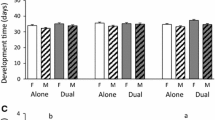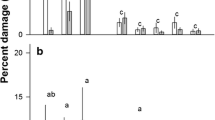Abstract
Numerous studies have explored the impacts of intraspecific genetic variation and environment on the induction of plant chemical defenses by herbivory. Relatively few, however, have considered how those factors affect within-plant distribution of induced defenses. This work examined the impacts of plant genotype and soil nutrients on the local and systemic phytochemical responses of trembling aspen (Populus tremuloides) to defoliation by gypsy moth (Lymantria dispar). We deployed larvae onto foliage on individual tree branches for 15 days and then measured chemistry in leaves from: 1) branches receiving damage, 2) undamaged branches of insect-damaged trees, and 3) branches of undamaged control trees. The relationship between post-herbivory phytochemical variation and insect performance also was examined. Plant genotype, soil nutrients, and damage all influenced phytochemistry, with genotype and soil nutrients being stronger determinants than damage. Generally, insect damage decreased foliar nitrogen, increased levels of salicinoids and condensed tannins, but had little effect on levels of a Kunitz trypsin inhibitor, TI3. The largest damage-mediated tannin increases occurred in leaves on branches receiving damage, whereas the largest salicinoid increases occurred in leaves of adjacent, undamaged branches. Foliar nitrogen and the salicinoid tremulacin had the strongest positive and negative relationships, respectively, with insect growth. Overall, plant genetics and environment concomitantly influenced both local and systemic phytochemical responses to herbivory. These findings suggest that herbivory can contribute to phytochemical heterogeneity in aspen foliage, which may in turn influence future patterns of herbivory and nutrient cycling over larger spatial scales.





Similar content being viewed by others
References
Agrawal AA, Tuzun S, Bent E (1999) Induced plant defenses against pathogens and herbivores: Biochemistry, ecology, and agriculture. American Phytopathological Society Press, St. Paul
Anderson MJ (2001) A new method for non-parametric multivariate analysis of variance. Aust Ecol 26:32–46
Arnold TM, Schultz JC (2002) Induced sink strength as a prerequisite for induced tannin biosynthesis in developing leaves of Populus. Oecologia 130:585–593
Arnold TM, Appel HM, Schultz JC (2012) Is polyphenol induction simply a result of altered carbon and nitrogen accumulation? Plant Signal Behav 7:1498–1500
Ayres MP, Clausen TP, MacLean SF, Redman AM, Reichardt PB (1997) Diversity of structure and antiherbivore activity in condensed tannins. Ecology 78:1696–1712
Babst BA, Sjodin A, Jansson S, Orians CM (2009) Local and systemic transcriptome responses to herbivory and jasmonic acid in Populus. Tree Genet Genomes 5:459–474
Barbehenn RV, Constabel CP (2011) Tannins in plant-herbivore interactions. Phytochemistry 72(13):1551–1565
Boeckler GA, Gershenzon J, Unsicker SB (2011) Phenolic glycosides of the Salicaceae and their role as anti-herbivore defenses. Phytochemistry 72:1497–1509
Boeckler GA, Gershenzon J, Unsicker SB (2013) Gypsy moth caterpillar feeding has only a marginal impact on phenolic compounds in old-growth black poplar. J Chem Ecol 39:1301–1312
Boeckler GA, Towns M, Unsicker SB, Mellway RD, Yip L, Hilke I, Gershenzon J, Constabel CP (2014) Transgenic upregulation of the condensed tannin pathway in poplar leads to a dramatic shift in leaf palatability for two tree-feeding Lepidoptera. J Chem Ecol 40:150–158
Cole CT (1995) Allelic and population variation of microsatellite loci in aspen (Populus tremuloides). New Phytol 67:155–164
Couture JJ, Lindroth RL (2012) Atmospheric change alters performance of an invasive forest insect. Global Change Biol 18:3543–3557
Couture JJ, Lindroth RL (2014) Atmospheric change alters frass quality of forest canopy herbivores. Arthropod Plant Interact 8:33–47
Donaldson JR, Lindroth RL (2007) Genetics, environment, and their interaction determine efficacy of chemical defense in trembling aspen. Ecology 88:729–739
Eyles A, Bonello P, Ganley R, Mohammed C (2009) Induced resistance to pests and pathogens in trees. New Phytol 185:893–908
Frost CJ, Appel HM, Carlson JE, De Moraes CM, Mescher MC, Schultz JC (2007) Within-plant signaling via volatiles overcomes vascular constraints on systemic signaling and primes responses against herbivores. Ecol Lett 10:490–498
Glynn C, Herms DA, Egawa M, Hansen R, Mattson WJ (2003) Effects of nutrient availability on biomass allocation as well as constitutive and rapid induced herbivore resistance in poplar. Oikos 101:385–397
Hagerman AE, Butler LG (1980) Condensed tannin purification and characterization of tannin-associated proteins. J Agric Food Chem 28:947–952
Haruta M, Major IT, Christopher ME, Patton JJ, Constabel CP (2001) A Kunitz trypsin inhibitor gene family from trembling aspen (Populus tremuloides Michx.): cloning, functional expression, and induction by wounding and herbivory. Plant Mol Biol 46:347–359
Heil M (2010) Plastic defense expression in plants. Evol Ecol 24:555–569
Hemming JDC, Lindroth RL (1995) Intraspecific variation in aspen phytochemistry - effects on performance of gypsy moths and fortest tent caterpillars. Oecologia 103:79–88
Hemming JDC, Lindroth RL (2000) Effects of phenolic glycosides and protein on gypsy moth (Lepidoptera: Lymantriidae) and forest tent caterpillar (Lepidoptera: Lasiocampidae) performance and detoxication activities. Environ Entomol 29:1108–1115
Jones CG, Hopper RF, Coleman JS, Krischik VA (1993) Control of systemically induced herbivore resistance by plant vascular architecture. Oecologia 93(3):452–456
Karban R, Baldwin IT (1997) Induced responses to herbivory. University of Chicago Press, Chicago
Koricheva J, Shevtsova A (2002) Pitfalls in interpretation of allelochemical data in ecological studies: Implications for plant-herbivore and allelopathic research. In: Inderjit MAU (ed) Chemical ecology of plants: Allelopathy in aquatic and terrestrial systems. Birkhauser Verlag, Boston, pp 212–244
Lindroth RL, Bloomer MS (1991) Biochemical ecology of the forest tent caterpillar- responses to dietary protein and phenolic glycosides. Oecologia 86:408–413
Lindroth RL, Hemming JDC (1990) Responses of the gypsy moth (Lepidoptera, Lymantriidae) to tremulacin, an aspen phenolic glycoside. Environ Entomol 19:842–847
Lindroth RL, St. Clair SB (2013) Adaptations of quaking aspen (Populus tremuloides Michx.) for defense against herbivores. Forest Ecol Manag 299:14–21
Lindroth RL, Hsia MTS, Scriber JM (1987) Characterization of phenolic glycosides from quaking aspen. Biochem Syst Ecol 15:677–680
Lindroth RL, Scriber JM, Hsia MTS (1988) Chemical ecology of the tiger swallowtail- mediation of host use by phenolic glycosides. Ecology 69:814–822
Lindroth RL, Kinney KK, Platz CL (1993) Responses of deciduous trees to elevated atmospheric CO2: productivity, phytochemistry, and insect performance. Ecology 74:763–777
Lou YG, Baldwin IT (2004) Nitrogen supply influences herbivore-induced direct and indirect defenses and transcriptional responses to Nicotiana attenuata. Plant Physiol 135:496–506
Ma YA, Zhao Q, Lu MZ, Wang JH (2011) Kunitz-type trypsin inhibitor gene family in Arabidopsis and Populus trichocarpa and its expression response to wounding and herbivore in Populus nigra. Tree Genet Genomes 7(2):431–441
Madritch MD, Lindroth RL (2015) Condensed tannins increase nitrogen recovery by trees following insect defoliation. New Phytol. doi:10.1111/nph.13444
Madritch MD, Donaldson JR, Lindroth RL (2007) Canopy herbivory can mediate the influence of plant genotype on soil processes through frass deposition. Soil Biol Biochem 39:1192–1201
Major IT, Constabel CP (2008) Functional analysis of the Kunitz trypsin inhibitor family in poplar reveals biochemical diversity and multiplicity in defense against herbivores. Plant Physiol 146:888–903
Mattson WJ (1980) Herbivory in relation to plant nitrogen-content. Annu Rev Ecol Syst 11:119–161
McManus M, Schneeberger N, Reardon R, Mason G (1989) Forest insect and disease leaflet 162: Gypsy moth
Mellway RD, Tran LT, Prouse MB, Campbell MM, Constabel CP (2009) The wound-, pathogen-, and ultraviolet B-responsive MYB134 gene encodes an R2R3 MYB transcription factor that regulates proanthocyanidin synthesis in poplar. Plant Physiol 150:924–941
Neiman M, Olson MS, Tiffin P (2009) Selective histories of poplar protease inhibitors: elevated polymorphism, purifying selection, and positive selection driving divergence of recent duplicates. New Phytol 183:740–750
Osier TL, Lindroth RL (2001) Effects of genotype, nutrient availability, and defoliation on aspen phytochemistry and insect performance. J Chem Ecol 27:1289–1313
Osier TL, Lindroth RL (2004) Long-term effects of defoliation on quaking aspen in relation to genotype and nutrient availability: plant growth, phytochemistry and insect performance. Oecologia 139:55–65
Perala DA, Carpenter EM (1985) Aspen. U.S. Department of Agriculture, Washington
Philippe RN, Bohlmann J (2007) Poplar defense against insect herbivores. Can J Bot 85:1111–1126
Philippe RN, Ralph SG, Mansfield SD, Bohlmann J (2010) Transcriptome profiles of hybrid poplar (Populus trichocarpa x deltoides) reveal rapid changes in undamaged, systemic sink leaves after simulated feeding by forest tent caterpillar (Malacosoma disstria). New Phytol 188:787–802
Porter LJ, Hrstich LN, Chan BG (1986) The conversion of procyanidins and prodelphinidins to cyanidin and delphinidin. Phytochemistry 25:223–230
Ramirez CC, Guerra FP, Zuniga RE, Cordero C (2009) Differential expression of candidate defense genes of poplars in response to aphid feeding. J Econ Entomol 102:1070–1074
Schultz JC, Appel HM, Ferrieri AP, Arnold TM (2013) Flexible resource allocation during plant defense responses. Front Plant Sci 4:1–11
Schweitzer JA, Madritch MD, Bailey JK, LeRoy CJ, Fischer DG, Rehill BJ, Lindroth RL, Hagerman AE, Wooley SC, Hart SC, Whitham TG (2008) From genes to ecosystems: The genetic basis of condensed tannins and their role in nutrient regulation in a Populus model system. Ecosystems 11:1005–1020
Sellmer JC, McCown BH, Haissig BE (1989) Shoot culture dynamics of six Populus clones. Tree Physiol 5:219–227
Stevens MT, Lindroth RL (2005) Induced resistance in the indeterminate growth of aspen (Populus tremuloides). Oecologia 145:298–306
Stevens MT, Gusse AC, Lindroth RL (2012) Genotypic differences and prior defoliation affect re-growth and phytochemistry after coppicing in Populus tremuloides. J Chem Ecol 38:306–314
Strauss SY, Agrawal AA (1999) The ecology and evolution of plant tolerance to herbivory. Trends Ecol Evol 14:179–185
Tsai CJ, Harding SA, Tschaplinski TJ, Lindroth RL, Yuan YN (2006) Genome-wide analysis of the structural genes regulating defense phenylpropanoid metabolism in Populus. New Phytol 172:47–62
Wold S, Ruhe A, Wold H, Dunn WJ (1984) The collinearity problem in linear regression. The partial least squares (PLS) approach to generalized inverses. SIAM J Sci Stat Comp 5:735–743
Wold S, Sjöström M, Eriksson L (2001) PLS-regression: a basic tool of chemometrics. Chemometr Intell Lab 58:109–130
Acknowledgments
This work was funded by grants from the National Science Foundation (DEB-0074427, DEB-0344019, and DEB-0841609). We are grateful to Adam Gusse for technical assistance in completing this study.
Author information
Authors and Affiliations
Corresponding author
Rights and permissions
About this article
Cite this article
Rubert-Nason, K.F., Couture, J.J., Major, I.T. et al. Influence of Genotype, Environment, and Gypsy Moth Herbivory on Local and Systemic Chemical Defenses in Trembling Aspen (Populus tremuloides). J Chem Ecol 41, 651–661 (2015). https://doi.org/10.1007/s10886-015-0600-z
Received:
Revised:
Accepted:
Published:
Issue Date:
DOI: https://doi.org/10.1007/s10886-015-0600-z




